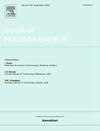Deconvolution approach for determining absolute prompt γ-ray intensities of 52V yielded from the 51V(n, γ)52V reaction at the Dalat Nuclear Research Reactor
IF 2.3
3区 工程技术
Q1 NUCLEAR SCIENCE & TECHNOLOGY
引用次数: 0
Abstract
All previous research relied on equipment such as Compton suppression spectrometers or coincidence spectrometers to determine the absolute prompt -ray intensities of 52V obtained from 51V(n, ) reaction. In the present work, we utilize a deconvolution method to determine the absolute prompt -ray intensities of the 52V measured by the HPGe detector of the PGNA spectrometer at horizontal channel No. 2 of the Dalat Nuclear Research Reactor (DNRR). This new method is based on the validated Geant4 simulation to deconvolute the prompt -ray spectrum of 52V and an in-beam saturated neutron capture reaction in a vanadium foil as the research sample and self-internal standard. Subsequently, by counting the 1.434 MeV delayed -ray peak emitted by 52V, the absolute prompt -ray intensities can be obtained. These -ray intensities were then compared to those in the ENSDF database and other references, which show a good agreement.
用反褶积法测定大拉核研究堆51V(n, γ)52V反应产生的52V绝对提示γ射线强度
以前所有的研究都依赖于康普顿抑制光谱仪或符合光谱仪等设备来确定51V(n, γ)反应获得的52V的绝对提示γ射线强度。在本研究中,我们利用反褶积方法确定了在大拉特核研究堆(DNRR) 2号水平通道上由PGNA光谱仪的HPGe探测器测量的52V的绝对提示γ射线强度。该方法基于经过验证的Geant4模拟,以钒箔为研究样品和自内标,对52V的激发γ射线谱和束流内饱和中子俘获反应进行反卷积。随后,通过计算52V发射的1.434 MeV延迟γ射线峰,可以得到绝对提示γ射线强度。然后将这些γ射线强度与ENSDF数据库和其他参考文献中的数据进行比较,结果显示出良好的一致性。
本文章由计算机程序翻译,如有差异,请以英文原文为准。
求助全文
约1分钟内获得全文
求助全文
来源期刊

Annals of Nuclear Energy
工程技术-核科学技术
CiteScore
4.30
自引率
21.10%
发文量
632
审稿时长
7.3 months
期刊介绍:
Annals of Nuclear Energy provides an international medium for the communication of original research, ideas and developments in all areas of the field of nuclear energy science and technology. Its scope embraces nuclear fuel reserves, fuel cycles and cost, materials, processing, system and component technology (fission only), design and optimization, direct conversion of nuclear energy sources, environmental control, reactor physics, heat transfer and fluid dynamics, structural analysis, fuel management, future developments, nuclear fuel and safety, nuclear aerosol, neutron physics, computer technology (both software and hardware), risk assessment, radioactive waste disposal and reactor thermal hydraulics. Papers submitted to Annals need to demonstrate a clear link to nuclear power generation/nuclear engineering. Papers which deal with pure nuclear physics, pure health physics, imaging, or attenuation and shielding properties of concretes and various geological materials are not within the scope of the journal. Also, papers that deal with policy or economics are not within the scope of the journal.
 求助内容:
求助内容: 应助结果提醒方式:
应助结果提醒方式:


